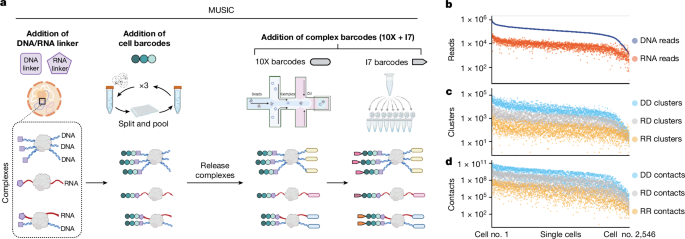Insights into Chromatin and RNA Interactions in Ageing Human Brain
核心概念
Chromatin interactions in ageing human brain cells impact gene expression and disease pathology.
摘要
The content introduces the MUSIC technique for analyzing chromatin interactions, gene expression, and RNA associations in individual nuclei. It highlights the correlation between chromatin interactions, gene expression, and Alzheimer's disease pathology in older donors' frontal cortex samples. The study also reveals the impact of chromatin contacts on gene expression and the heterogeneous interactions between XIST non-coding RNA and chromosome X in female cortical cells.
客製化摘要
使用 AI 重寫
產生引用格式
翻譯原文
翻譯成其他語言
產生心智圖
從原文內容
前往原文
www.nature.com
Single-cell multiplex chromatin and RNA interactions in ageing human brain - Nature
統計資料
Chromatin complex compositions change during cellular differentiation and ageing.
Nuclei with fewer short-range chromatin interactions correlate with an 'older' transcriptomic signature and Alzheimer's disease pathology.
Female cortical cells exhibit diverse interactions between XIST non-coding RNA and chromosome X.
引述
"MUSIC delineated diverse cortical cell types and states."
"Nuclei with fewer short-range chromatin interactions were correlated with both an 'older' transcriptomic signature and Alzheimer's disease pathology."
從以下內容提煉的關鍵洞見
by Xingzhao Wen... 於 www.nature.com 03-27-2024
https://www.nature.com/articles/s41586-024-07239-w
深入探究
How do chromatin interactions differ between various cell types in the ageing brain
In the ageing brain, chromatin interactions vary significantly between different cell types. The multinucleic acid interaction mapping in single cells (MUSIC) technique revealed that nuclei with fewer short-range chromatin interactions correlated with an 'older' transcriptomic signature and Alzheimer's disease pathology. This suggests that changes in chromatin interactions may play a role in the ageing process and neurodegenerative diseases. Additionally, the study identified diverse cortical cell types and states based on their chromatin interactions, highlighting the complexity and heterogeneity of chromatin organization in the ageing brain.
What are the implications of the observed chromatin contacts on gene expression regulation
The observed chromatin contacts have important implications for gene expression regulation. The study found that the cell type exhibiting chromatin contacts between cis expression quantitative trait loci (eQTLs) and a promoter is the one in which these eQTLs specifically influence the expression of their target gene. This indicates that chromatin interactions play a direct role in regulating gene expression by facilitating the interaction between regulatory elements and gene promoters. Understanding these chromatin contacts can provide insights into the mechanisms underlying gene expression changes in the ageing brain and their potential contribution to neurodegenerative diseases.
How can the findings of this study contribute to understanding neurodegenerative diseases beyond Alzheimer's
The findings of this study can contribute significantly to understanding neurodegenerative diseases beyond Alzheimer's. By uncovering the relationship between chromatin interactions, gene expression, and disease pathology in the ageing brain, researchers can gain insights into the molecular mechanisms underlying various neurodegenerative conditions. The identification of specific chromatin interactions associated with Alzheimer's disease pathology suggests that similar chromatin changes may occur in other neurodegenerative diseases, providing a potential avenue for further research and therapeutic development. Additionally, the study's focus on diverse cortical cell types and their chromatin organization can help elucidate the cellular and molecular changes that occur in different brain regions affected by neurodegenerative diseases, offering new targets for intervention and treatment strategies.
0
